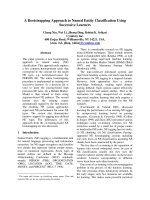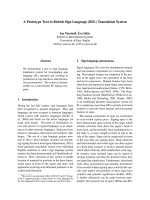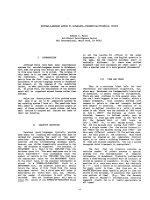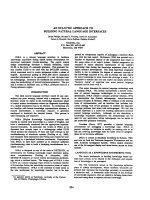Báo cáo khoa học: "Natural Language Front-Ends to Databases: Design and the Customisation Bottleneck" pdf
Bạn đang xem bản rút gọn của tài liệu. Xem và tải ngay bản đầy đủ của tài liệu tại đây (117.02 KB, 1 trang )
Natural Language Front-Ends to Databases:
Design and the Customisation Bottleneck
Anne De Roeck
University of Essex Department of Computer Science
Wivenhoe Park Colchester CO4 3SQ
e-mail •
1. SQUIRREL: Motivation and Design.
NLFE to databases have failed in a commercial
context, largely because of two reasons. Current
approaches to the management of ambiguity by relying
on inference over a world model create ungoing
customisation requirements. Furthermore the design of
NLFEs is subject to constraints which research in CL/
NLP does not address. In particular, standard parsing
techniques (including "robust" ones) require complete
lexica and cannot be deployed because new data would
create a constant need for dictionary update.
The SQUIRREL [1] system (SERC Grant GR/E/
69485) addresses some of these problems: its design
reduces customisation effort as words are interpreted
without reference to world models. The lexicon is
assumed to be incomplete: unknown words are given
interpretations by exploiting typing information
contained in the datamodel. In addition, SQUIRREL
demonstrates that NLFEs can allow for interrogation of
integrity constraints, usually invisible to users. It is
important to note that no "new" aspects of standard
database management systems are involved
SQUIRREl. intends to explore to what extent the
state of the art in NLP/CL and Formal Semantics can be
exploited in the design of NLFE to relational databases,
under constraints imposed by good sofware engineering
protocol. It aims to develop a modular, portable design,
to plug in to public domain database technology,
requiring minimal customisation.
SQUIRREl. consists of a series of mappings
translating NL expressions into SQL. Its highly modular
design allows parts of the system to be ported without
affecting other parts. Expressions in English are
assigned syntactic and semantic representations on the
basis of a lexicon and a context-free feature ba~d
grammar. The lexicon is incomplete: unknown words are
assigned tentative categories by the (bi-directional chart)
parser. Syntactic and semantic rules operate in tandem.
Semantic representations are cast in Property Theory
(P'D [2], delivering "intensional" objects. These are
assigned extensions in the form of first order logic (FOL)
expressions. So far, the representations are independent
from the domain model of any database in question.
The FOL expressions are translated into the domain
relational calculus (DRC), by rules exploiting the
logical structure of the FOL formulae, and a domain
model. The resulting expressions are translated into SQL
by a simple syntactic transduction.
The design offers several cut-off points at which
modules can be re-deployed. The lexicon and granunar,
currently written for a subset of English, can readily be
customised for any language for which a context-free
feature based grammar exists. The step via PT offers a
second point where the system can be deployed to
applications other than database interfaces. The mapping
into the DRC makes it possible to port the system to any
relational query language.
The real advance made in this system is the economy
of its datamodel. It sets out how each word in the
dictionary is to be understood w.r.t, the current database
by direct mapping: no world knowledge or inference is
required. Unknown words are filled in by typing
constraints associated with domains in the datamodel.
No loss of expressiveness is entailed: this is hardly
surprising as all a world model would seek to do is to (i)
exaggerate ambiguity w.r.t, how a user might perceive
the world, in order to (ii) reduce that ambiguity w.r.t.
what the current database can provide. Under this view,
step (i) is totally superfluous. The resulting gain in
customisation effort is paramount.
SQUIRREI.'s ambiguity management strategy is to
offer users a choice between all interpretations that have
survived the mapping into SQL. Note that at each stage
in the mapping, alternative representations may emerge,
or existing ones may die off. The most powerful
disambiguation tool is the exploitation Of typing
constraints associated with the database itself.
2. Modality: the spin-off
SQUIRREl. demonstrates that a NLFE can supply
information which is not open to even proficient query
language users. Relational databases are associated with
integrity constraints to provide consistency of data
across modifications over time. These constraints are not
visible to users. It is possible to view such constraints as
governing "possible" legal states of the database, the
current database being one. As such, they can be used to
answer modal queries about alternative states of affairs.
When SQUIRREL is faced with a modal query, it
attempts an update (via SQL), which would change the
database into the required state. If the update is rejected,
it collects feed-back as to which constraints have been
violated and offers it to the user. By doing this, the
system turns any database with integrity constraints into
a "knowledge" base, without the need for explicit
inference.
References
[1 ] De Roeck, A., C. Fox, B. Lowden, R. Turner
and
B. Walls, A Natural Language System based on Formal
Semantics, International Conference on Computational
Linguistics, Penang, Malaysia, 1991.
[2] Turner, R. A Theory of Properties, Journal of
Symbolic Logic, Vol 52 no2., 1987
474









